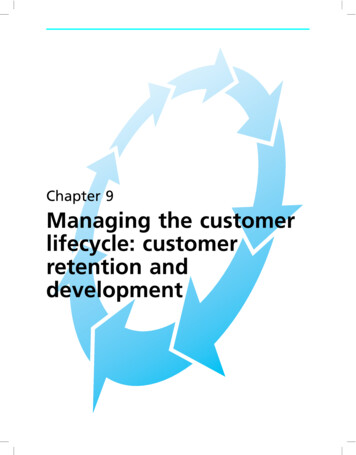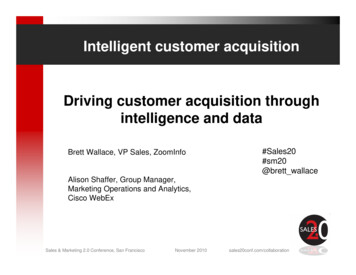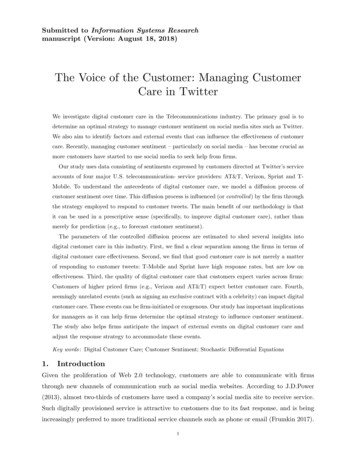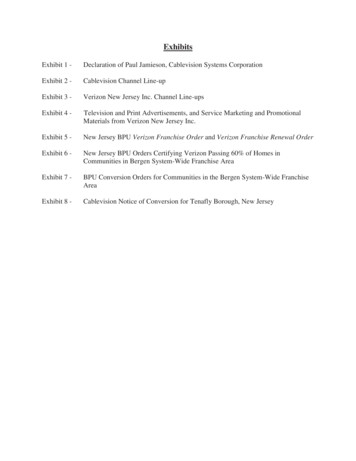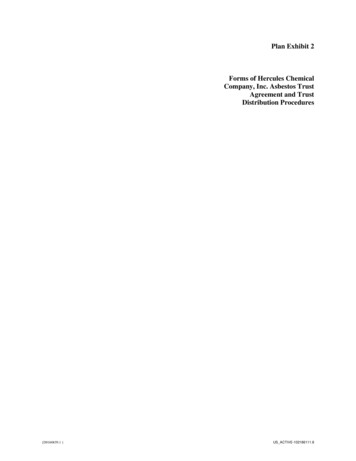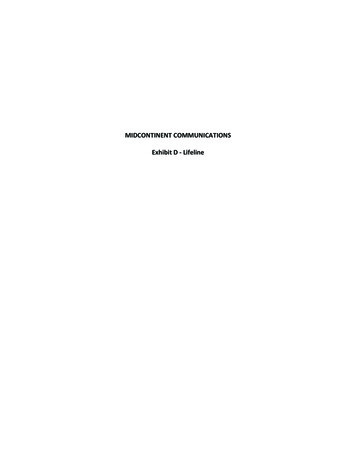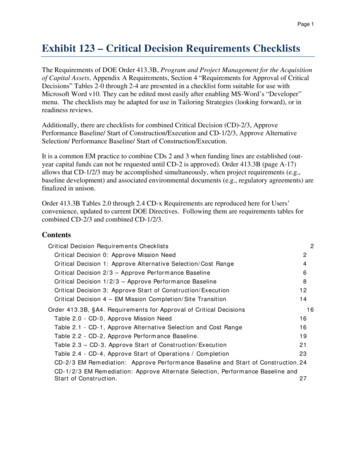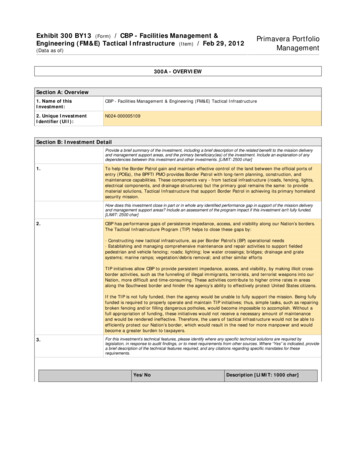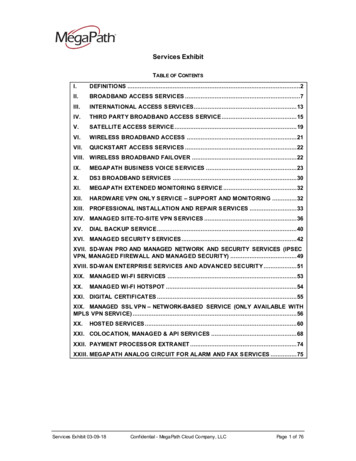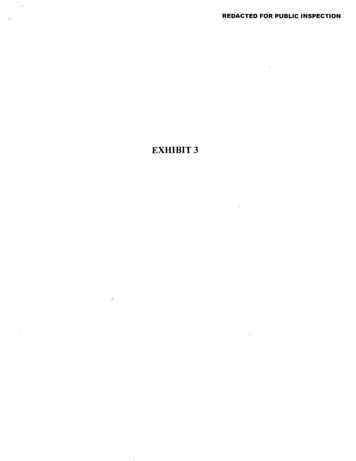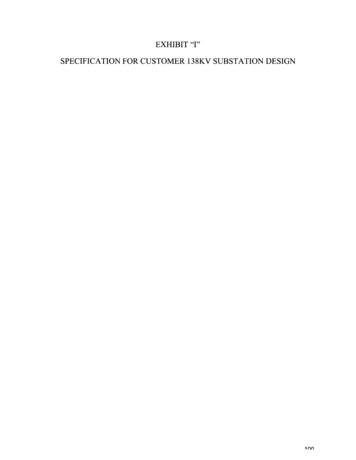
Transcription
EXHIBIT "I"SPECIFICATION FOR CUSTOMER 138KV SUBSTATION DESIGN
SPECIFICATIONFORCUSTOMER-OWNED 138 kV SUBSTATION DESIGNAkwCenterPointEnergyELECTRIC ENGINEERING DEPARTMENTP.O. BOX 1700 HOUSTON, TEXAS 77251REFERENCE DRAWINGS: Latest revision ofCenterPoint Energy 004-241-04, Customer-Owned Substation Line Termination StandardCenterPoint Energy 171-190-06, Design Criteria 138 kV Standard Instrument Transformer Stand, Sh.'s1 and 2CenterPoint Energy 581-500-01, 138 kV Potential Transformer Schematic and Wiring DiagramREFERENCE DOCUMENT: Latest revision ofCenterPoint Energy Transmission & Substation Outage and Clearance Coordination ProceduresREFERENCE SPECIFICATIONS: Latest revision ofCenterPoint Energy 007-400-02, Specification for Remote Telemetry of a Customer-Owned FacilityREFERENCE STANDARDS: Latest revision ofAASHTOAISC, "Manual of Steel Construction"ASCE 10ASCE 113ANSI C12.1ANSI C37.32IEEE C37.06IEEE C37.04IEEE C37.40IEEE C37.60IEEE date Sections 8 & 9 for TelecomUpdatesChange to 4000A and other updatesITEMS RIVISEDIEEE C57.13IEEE C2 (NESC)IEEE 80IEEE 519IEEE 837IEEE 1119IEEE 998IEEE 142IEEE 1453NEMA CC 1minVarVarBYVarVarVarCHCENTERPOINT ENERGYHOUSTON, TEXAS) WRITTEN4/9/74E. C. ReidVIDE CHECKED4/10/74 L. G. PondDRS APPROVED7/17/74 C. S. KayserDRSPage 1 of 45SPECIFICATION NO. 007 231 14APP,4101
Table of Contents1. SCOPE32. GENERAL33. CENTERPOINT ENERGY SYSTEM CHARACTERISTICS44. ELECTRICAL DESIGN CRITERIA55. STRUCTURAL AND MECHANICAL DESIGN CRITERIA136. SITE CRITERIA167. HIGH VOLTAGE EQUIPMENT188. CONTROL CUBICLE219. METERING EQUIPMENT2210. FUSING AND CONNECTION OF PROTECTION AND CONTROL AND METERING CIRCUITS2611. PROTECTIVE RELAYING FOR HIGH VOLTAGE (138 KV)2812. REMOTE TELEMETRY3313. GENERATION3314. DRAWING AND DOCUMENTATION COMPLIANCE REVIEW AND COMMENTS3415. EQUIPMENT INSTALLATION3616. REQUIRED TESTS AND INSPECTIONS3717. RECOMMENDED TESTS AND INSPECTIONS39REFERENCE pdate Sections 8 & 9 for TelecomUpdatesChange to 4000A and other updatesITEMS REVISEDcwmVarVarBY 1VarVarVarCHMDBDRSDRSAPPCENTERPOINT ENERGYHOUSTON, TEXASWRITTEN4/9/74 1 E. C. ReidCHECKED4/10/74 1 L. G. PondAPPROVED7/17/74 1 C. S. KayserPage 2 of 45SPECIFICATION NO. 007 231 14
1. SCOPE1.1.This specification covers design criteria for a customer-owned 138 kV substation connected to theCenterPoint Energy Houston Electric, LLC (CenterPoint Energy) 138 kV transmission system. Thisspecification is intended to apply to a new customer-owned substation or expansion of an existingcustomer-owned substation. However, the information in this specification may be applicable whenequipment in an existing customer-owned substation is being replaced or modified.2. GENERAL2.1.A customer that is approved by CenterPoint Energy to receive service from the CenterPoint Energy 138kV transmission system is required to provide a substation capable of accepting that service fromCenterPoint Energy. The customer-owned substation becomes an integral part of the CenterPointEnergy transmission system network and the Electric Reliability Council of Texas (ERCOT) and,therefore, can have a significant impact on overall system reliability. The customer is obligated to meetpresent CenterPoint Energy design criteria and modify the customer-owned substation in the future asthe CenterPoint Energy transmission system continues to evolve. When deemed necessary byCenterPoint Energy, changes may be needed to conform to industry standards, transmission systemcharacteristics, CenterPoint Energy practices, and technological advances to maintain reliability ormeet future reliability requirements.2.2.All equipment shall be in accordance with designated standards of this specification, the AmericanNational Standards Institute (ANSI), the Institute of Electrical and Electronic Engineers (IEEE), theAmerican Society of Civil Engineers (ASCE), the American Institute of Steel Construction (AISC),and the National Electrical Manufacturing Association (NEMA). In the event of conflictingrequirements, the order of precedence shall be this specification, ANSI, IEEE, ASCE, AISC, andNEMA standards. All electrical clearances shall comply with the latest version of the National ElectricSafety Code (NESC).2.3.This specification is not intended to be totally comprehensive. To ensure the efficient coordinationbetween CenterPoint Energy and the customer during the design and construction of the customerowned substation, CenterPoint Energy requires that engineering documents be submitted toCenterPoint Energy for review before certain equipment is ordered or construction begins. All itemsrequiring CenterPoint Energy review are listed in Article 14 of this specification and shall be submittedin writing to the designated CenterPoint Energy representative.2.4.Any deviations from this specification or project drawings reviewed by CenterPoint Energy requirewritten acceptance from CenterPoint Energy.2.5.All labor and equipment shall be furnished by the customer unless otherwise stated in this specification.2.6.Unless otherwise stated in this specification:2.6.1.CenterPoint Energy will provide only functional reviews of completed drawings andschematics.2.6.2.CenterPoint Energy will not verify, or correct, point-to-point wiring drawings for the customer—owned substation.CENTERPOINT ENERGY1615148-3-201711-16-20157-22-2005Update Sections 8 & 9 for TelecomUpdatesChange to 4000A and other updatescwmVarVarVarVarVarMDBDRSDRSNODATEITEMS REVISEDBYCHAPPHOUSTON, TEXASWRITTEN4/9/74E. C. ReidCHECKED4/10/74 L. G. PondAPPROVED7/17/74 C. S. KayserPage 3 of 45SPECIFICATION NO. 007 231 141 rrl
2.6.3.CenterPoint Energy requires specific tests which are to be conducted by the customer to verifythe proper operation and coordination of the customer-owned substation protection and controlequipment (see Article 16 of this specification).2.7.CenterPoint Energy reserves the right to refuse to energize any customer-owned substation which failsto meet this specification.2.8.The customer will coordinate the energization and operation of their high voltage facilities withCenterPoint Energy's Real Time Operations (RTO) Department per CenterPoint Energy's"Transmission & Substation Outage and Clearance Coordination Procedures" document.2.9.During energization of new or existing equipment, the customer shall not disable a single level, ormultiple levels, of protection that results in no protection for an energized element, such as, atransmission line, high voltage bus, or transformers.2.9.1.The customer shall immediately notify the RTO System Controller (281-894-0491) wheneverthe customer becomes aware of an energized element that has no protection if the protectioncannot be immediately restored.2.9.2.The customer shall immediately notify the RTO System Controller (281-894-0491) of aprotective relay that is not functional (such as a "CPU Failure" alarm) or when a protectiverelay is found powered down, or out of service (such as not enabled), for an energized element2.10. As owner of the substation, it is the customer's responsibility to comply with the applicable laws,ordinances, codes, rules, and regulations established by applicable government entities.2.11. Because the customer-owned substation becomes an integral part of the CenterPoint Energytransmission system network, CenterPoint Energy requires access to the customer-owned substationand CenterPoint Energy right-of-ways 7 days-a-week, 24 hours-a-day, 365 days-a-year. Site access, siteoperating procedures and road access to the customer-owned substation by CenterPoint Energypersonnel should be considered when determining the substation location.2.12. When terminal blocks and other connections permit, ring tongue lugs shall be used instead of spade orstab-on lugs.3. CENTERPOINT ENERGY SYSTEM CHARACTERISTICS161514NO3.1.CenterPoint Energy's phase rotation is designated C-B-A counterclockwise and the customer shallphase equipment accordingly. Connection of the customer's H1-H2-H3 power transformer leads toCenterPoint Energy's C-B-A, B-A-C or A-C-B phases, respectively, is recommended.3.2.The CenterPoint Energy nominal system voltage is 138kV (L-L)/79.7kV (L-G) /- 5%. Actual steadystate operational voltage varies around the CenterPoint Energy transmission system network, butfacilities with a means to regulate the 138 kV transmission system are typically used to control thevoltage to be no more than approximately 142 kV (L-L)/82 kV (L-G) to provide a margin from themaximum 145kV (L-L)/83.7 kV (L-G). Dynamic conditions may be encountered which result involtage exceeding this range. For the purpose of the design and rating of the substation and equipment,8-3-201711-16-20157-22-2005DATEUpdate Sections 8 & 9 for TelecomUpdatesChange to 4000A and other updatesITEMS POINT ENERGYHOUSTON, TEXASWRITTEN4/9/74E. C. ReidCHECKED4/10/74 L. G. PondAPPROVED7/17/74 C. S. KayserPage 4 of 45SPECIFICATION NO. 007 231 141nA
it shall be assumed that the maximum continuous negative sequence component of the voltage at the138 kV bus is 2% of the positive sequence voltage. See Sub-Articles 3.4, 3.5, 4.7 and 7.1.4 of thisspecification for additional relevant information.3.3.Only instrument transformers, surge arresters, station service voltage transformers, generator step-uptransformers and autotransformers are allowed to be connected phase-to-ground on their 138 kVprimary terminals.3.4.As the independent system operator (ISO) for the ERCOT Region, ERCOT is responsible formaintaining frequency, which is nominally 60 Hz. Refer to ERCOT (www.ercot.com) NodalOperating Guides and Protocols for information regarding frequency regulation.3.5.The "voltage dip ride-through" design criteria, that CenterPoint Energy suggests the customer utilizewhen designing and selecting process and control equipment is illustrated in Figure 1 (Note: This designcriteria does not supersede any regulatory voltage ride-through requirements).V 50%k1V 100%i12 cyclesi"V" represents the phase-to-neutral voltage at the customer's "load side" of a deltawye transformer for a phase-to-ground fault at the "high-side" of the transformer.Figure 13.6.Multiple-shot, staggered, voltage-supervised, automatic reclosing is utilized on the CenterPoint Energytransmission system. The first automatic reclosing attempt for a CenterPoint Energy transmission linetypically occurs approximately one second after the fault has cleared. The number of automaticreclosing attempts varies, but the total duration of the automatic reclosing sequence is typically oneminute. The customer shall coordinate operation and protection of electric motors, computers andother equipment accordingly.4. ELECTRICAL DESIGN CRITERIA4.1.The minimum acceptable electrical design characteristics for 138 kV facilities and equipment are listedbelow:Transformer winding impulse level550 kV BILBus and switch insulators, and apparatusbushings (i.e., circuit breaker bushings,transformer bushings, coupling capacitors,capacitive voltage transformers (CVT),current transformers (CT), potentialtransformers (PT), surge arresters etc.)650 kV BILCENTERPOINT ENERGY1615148-3-201711-16-20157-22-2005Update Sections 8 & 9 for TelecomUpdatesChange to 4000A and other updatesCwrnVarVarVarVarVarMDBDRSDRSNODATEITEMS REVISEDBYCHAPPHOUSTON, TEXASWRITTEN4/9/74E. C. ReidCHECKED4/10/74 L. G. PondAPPROVED7/17/74 C. S. KayserPage 5 of 45SPECIFICATION NO. 007 231 141 rIg
impulse levelBus and switch insulators leakage distance132 in. leakage distance (equivalent to extra creep 650kV BIL or 750 kV BIL). Additionally, insulators mayrequire 'coating' in some areas of the system tominimize the likelihood of flashover.Apparatus bushing leakage distance (circuit 92 in. creep (equivalent to 650 kV BIL — lightbreaker bushings, transformer bushings, contamination levels). Additionally, apparatus bushingsCVT, CT, PT, surge arresters etc.)may require 'coating' in some areas of the system tominimize the likelihood of flashover.Phase-to-ground clearance52 in. (metal to metal)Phase-to-phase bus spacing (including 63 in. (metal to metal)vertical spacing at crossover point of highand low bus)Phase-to-phase horizontal spacing (center 144 in. (regardless of the line angle)line to center line) at incoming line deadend structure161514NO4.2.An air insulated customer-owned substation configured in a 'ring bus', 'double-breaker, double-bus' or'breaker-and-a-half arrangement equipped with transmission line protective relaying ("full loop") oran air insulated customer-owned substation configured in a 'loop line tap' arrangement withouttransmission line protective relaying ("loop tap") are allowed by CenterPoint Energy (see Figure 2through Figure 7).4.3.Based on the customer-owned substation configuration, equipment in the substation that is subjected totransmission line load flow current (circuit breakers and disconnect switches, bus work, conductors orany series-connected, current carrying devices, such as, free-standing current transformers, protectiverelays, instrumentation, or hardware within the ring bus or transmission line breaker-and-a-half bay)and incoming transmission line positions (transmission line disconnect switches, line traps, etc.) shallhave a continuous current rating of 4000 A minimum and shall have an overload capability of 110percent of rated current for 2 hours, unless otherwise specified by CenterPoint Energy. The equipmentin the customer-owned substation that is not subjected to transmission line load flow current is notrequired to be 4000 A minimum. However, operational scenarios associated with certain equipmentoutages could exist that would result in transmission line load current flowing on customer internallines or buses (customer site internal 'loop line' or customer site internal 'loop bus') and potentiallyoverload the customer's equipment if it is rated less than 4000 A. Therefore, CenterPoint Energysuggests that any customer site internal 'loop line' and customer site internal 'loop bus' (exceptcustomer site internal 'radial' line or customer transformer bus connections) be 4000 A minimum (seeFigure 2 through Figure 7). For customer-owned substations connecting to four or more CenterPointEnergy 138 kV transmission lines, contact CenterPoint Energy for the required equipment rating.8-3-201711-16-20157-22-2005DATEUpdate Sections 8 & 9 for TelecomUpdatesChange to 4000A and other updatesITEMS NT ENERGYHOUSTON, TEXASWRITTEN4/9/74E. C. ReidCHECKED4/10/74 L. G. PondAPPROVED7/17/74 C. S. KayserPage 6 of 45SPECIFICATION NO. 007 231 141R
CenterPoint Energynetwork transmission line --- DSCenterPoint Energynetwork transmission line*------ transmission lineload flowcurrentDS.1DSi,i,,DS,CB**1.-r .,I1\AANT1 ‘,", vvT2Alternative 'a' customer 138 kV substation ("loon tar,"12 circuit switchers with 1 or 2 transformers and circuit breakersCS circuit switcherCB circuit breakerDS disconnect switchL—Must have a continuous current rating of 4000 A minimumCan be less than 4000 AAll disconnect switches only have arcing horns. Circuit switchers arerequired to be installed in this configuration The circuit switchers areused for manual switching of the network transmission line sections. If two transformers are installed then this disconnect switch is installedand is 'normally closed'.** For substation arranged for future 'full loop" service. the 138 kV circuitbreakers that will be in the substation loop' shall have a continuouscurrent rating of 4.000 A (see figures 3 to 7)Figure 2161514NO8-3-201711-16-20157-22-2005DATEUpdate Sections 8 & 9 for TelecomUpdatesChange to 4000A and other updatesITEMS NT ENERGYHOUSTON, TEXASWRITTEN4/9/74E. C. ReidCHECKED4/10/74 L. G. PondAPPROVED7/17/74 C. S. KayserPage 7 of 45SPECIFICATION NO. 007 231 141(17
CenterPoint Energynetwork transmission line*----- CenterPoint Energynetwork transmission line - 4110.DSDSDS gDS transmission lineload flowcurrentDSDSCCBtransmission lineload flowcurrentCBDSDS*o':DS01%AA, , ., . ,A , ,/ T2v , v vDST1Alternative 'la' customer 138 kV substation ("loop tap"12 circuit breakers with 1 or 2 transformersCB circuit breakerDS disconnect switchMust have a continuous current rating of 4000 A minimumCan be less than 4000 AAll disconnect switches only have arcing horns. Circuit switchers are notused for manual switching of the network transmission line sections in thisconfiguration. The circuit breakers are used for manual switching of thenetwork transmission line sections.* lf two transformers are installed then this disconnect switch is installedand is 'normally open'.Figure 3161514NO8-3-201711-16-20157-22-2005DATEUpdate Sections 8 & 9 for TelecomUpdatesChange to 4000A and other updatesITEMS INT ENERGYHOUSTON, TEXASWRITTEN4/9/74E. C. ReidCHECKED4/10/74 L. G. PondAPPROVED7/17/74 C. S. KayserPage 8 of 45SPECIFICATION NO. 007 231 141rurt
CenterPoint Energynetwork transmission line — CenterPoint Energynetwork transmission line CBDSDSDSADSBDSDS4 - transmission lineload flowcurrentCBCCBtransmission lineload flowcurrentDS*DStto:DS?1DS\T1, ,vAAA/%IAAV //X/T2vAlternative 'c' customer 138 kV substation ("full loop"13 circuit breakers with 1 or 2 transformersCB circuit breakerDS disconnect switch—Must have a continuous current rating of 4000 A minimumCan be less than 4000 AAll disconnect switches only have arcing horns. Circuit switchers are notused for manual switching of the network transmission line sections in thisconfiguration. The circuit breakers are used for manual switching of thenetwork transmission line sections.* lf two transformers are installed then this DS is 'normally open' or'normally closed depending on customer operating preference.Figure 44.161514NO8-3-201711-16-20157-22-2005DATEUpdate Sections 8 & 9 for TelecomUpdatesChange to 4000A and other updatesITEMS INT ENERGYHOUSTON, TEXASWRITTEN4/9/74E. C. ReidCHECKED4/10/74 L. G. PondAPPROVED7/17/74 C. S. KayserPage 9 of 45SPECIFICATION NO. 007 231 14
CenterPoint Energynetwork transmission line ------- CenterPoint Energynetwork transmission line — 410.CBDSDSADSBDSDS4--- transmission lineload flowCBCtransmission lineload flowDSDSCBDSDSDDSDST2T1Alternative d' customer 138 kV substation ("full loov")4 circuit breakers with 2 transformersCB circuit breakerDS disconnect switch—Must have a continuous current rating of 4000 A minimumCan be less than 4000 AAll disconnect switches only have arcing horns. Circuit switchers are notused for manual switching of the network transmission line sections in thisconfiguration. The circuit breakers are used for manual switching of thenetwork transmission line sections.Figure 5161514NO8-3-201711-16-20157-22-2005DATEUpdate Sections 8 & 9 for TelecomUpdatesChange to 4000A and other updatesITEMS INT ENERGYHOUSTON, TEXASWRITTEN4/9/74E. C. ReidCHECKED4/10/74 L. G. PondAPPROVED7/17/74 C. S. KayserPage 10 of 45SPECIFICATION NO. 007 231 14.1 1 n
III'SO.DS --- CenterPoint Energynetwork transmission lineCBDSDSDSABtransmission lineload flowDSDSDS110. CenterPoint Energynetwork transmission lineDSDCDSiT1vDS\NT2Alternative 'e' customer 138 kV substation ("full loop")4 circuit breakers with 2 transformersCB circuit breakerDS disconnect switch—Must have a continuous current rating of 4000 A minimumCan be less than 4000 AAll disconnect switches only have arcing horns. Circuit switchers are notused for manual switching of the network transmission line sections in thisconfiguration. The circuit breakers are used for manual switching of thenetwork transmission line sections.Figure 6161514NO8-3-201711-16-20157-22-2005DATEUpdate Sections 8 & 9 for TelecomUpdatesChange to 4000A and other updatesITEMS INT ENERGYHOUSTON, TEXASWRITTEN4/9/74E. C. ReidCHECKED4/10/74 L. G. PondAPPROVED7/17/74 C. S. KayserPage 11 of 45SPECIFICATION NO. 007 231 14111
CenterPoint Energynetwork transmission lineCenterPoint Energynetwork transmission line*--- Il1DSDSDS4------- DSBtransmission lineload flowCBCtransmission lineload flowDSDSCBDSDS*.customer siteinternal 'loop lin& possibleftransmission line /% load flow I ' airs00customer siteinternal 'loop line'40DSDST1—T2Must have a continuous current rating of 4000 A minimumCan be less than 4000 Al.Any customer connection from the "full loop" substation or "loop tap"substation to the customer's transformers, customer buses, or customerlines (i e customer plant internal 'loop lines', etc ) are not required to be4000 A minimum. However, operational scenarios after a scheduledoutage of equipment in a customer substation could exist that would resultin transmission line load current flowing on customer site internal lines orbuses (customer site internal 'loop line' or loop bus') and potentiallyoverload the customer's equipment if it is rated less than 4000 ATherefore, CenterPoint Energy suggests that any customer site internal'loop line' and customer site internal 'loop bus' (except customer siteinternal 'radial' line or customer transformer bus connection) be 4000 AminimumFigure 7161514NO4.4.The 138 kV customer-owned substation shall be designed for a short circuit current of 63 kA rmssymmetrical, with X/R ratio of 15, unless otherwise specified by CenterPoint Energy.4.5.The application of key interlock systems are not permitted on customer-owned substation 138 kVequipment.4.6.The customer's connected load and equipment shall be designed and operated to adhere to therecommended harmonic limits of IEEE 519 and limits of voltage fluctuations and associated lightflicker of IEEE 1453.8-3-201711-16-20157-22-2005DATEUpdate Sections 8 & 9 for TelecomUpdatesChange to 4000A and other updatesITEMS NT ENERGYHOUSTON, TEXASWRITTEN4/9/74E. C. ReidCHECKED4/10/74 L. G. PondAPPROVED7/17/74 C. S. KayserPage 12 of 45SPECIFICATION NO. 007 231 14110
4.7.The customer shall not, without CenterPoint Energy's consent, connect or operate equipment thatproduces voltage fluctuations, interference or distorted wave forms that adversely affect service toother customers or that may be detrimental to the CenterPoint Energy transmission system. Suchequipment includes, but is not limited to, motors, arc furnaces, capacitor banks, etc. The customer isobligated to provide load and equipment information (i.e., load magnitude, peak load, load profile,amount of self-serve generation, load characteristics, motor starting data, load increase) for CenterPointEnergy interconnection study and development of interconnection requirements. CenterPoint Energymay require the installation, on customer's side of the meter, of suitable apparatus or other equipmentdesigned specifically to reasonably limit such adverse effects.4.8.The customer-owned substation ground mat shall be designed for a short circuit current of 63 kA rmssymmetrical with X/R ratio of 15 and duration of 0.25 seconds and comply with IEEE 80 and IEEE C2(NESC). Ground mat connections shall comply with IEEE 837, unless otherwise specified byCenterPoint Energy.4.9.The customer-owned substation direct lightning stroke shielding design shall comply with IEEE 998.4.10. The customer shall refer to the current CenterPoint Energy tariff for retail delivery service regardingadditional information pertaining to load balance, intermittent electrical loads and limitations onadverse effects, equipment sensitive to voltage and wave forms, change in retail customer's electricalload, power factor, and testing of retail customer equipment.5. STRUCTURAL AND MECHANICAL DESIGN CRITERIA5.1.The customer shall provide a complete structural and foundation design package for the dead-endstructures (supporting the CenterPoint Energy transmission lines connected to the customer-ownedsubstation) and the instrument transformer stands in accordance with Article 14 of this specification.The design package shall be signed and sealed by a professional engineer registered in Texas and shallinclude design references/codes, computer analysis, member design, connection design, foundationdesign, soil report, structural and foundation drawings, and all other information that documents thedesign of the structure(s). ASCE 113 may be used for guidance in the design of structures inside thecustomer-owned substation.5.2.Design shall be based upon loadings realistically combined to cause the most unfavorable effect uponthe structure or component. The loads and overloads used in Sub-Article 5.4 of this specification mustbe used. The AISC LRFD method is preferred, and the structure must have a second order elasticanalysis (also called a Geometric Nonlinear Analysis). Refer also to Sub-Article 5.4 and 5.5.5 of thisspecification.5.3.Structures shall meet the Strength Requirements of IEEE C2 (NESC), Section 26, for grade Bconstruction.5.4.The minimum acceptable structural design loading criteria shall be the more severe of the followingtwo cases (note the cases incorporate loads up to a 30 degree angle):5.4.1.Case 1 - Combined Ice and Wind Loading: Reference specification IEEE C2 (NESC); minimumallowable strength factors per Section 26, Table 261-1; loading requirements per Section 25,Rule 250.B and Table 250-1; and loading components to be applied to the structure shall beCENTERPOINT ENERGY1615148-3-201711-16-20157-22-2005Update Sections 8 & 9 for TelecomUpdatesChange to 4000A and other updatescwmVarVarVarVarVarMDBDRSDRSNODATEITEMS REVISEDBYCHAPPHOUSTON, TEXASWRITTEN4/9/74E. C. ReidCHECKED4/10/74 L. G. PondAPPROVED7/17/74 C. S. KayserPage 13 of 45SPECIFICATION NO. 007 231 14111
according to Figure 8 of this specification. The static wire and phase wire loads shown in Case 1include the required overload factors. The wind on the structure must include a 2.50 overload.Transverse*lirLongitudinal Winddirectioni.! -o- StSt —1osht- It ,1---rtTiT1Tir SIWind and Ice loads are specified in Section 25 of IEEE C2Static wireSI 10.5 kips/wire longitudinallySt 6.7 kips/wire transverselySv 0.5 kips/wire verticallyPhase wireTl 23.0 kips/phase longitudinallyTt 14.4 kips/phase transverselyTv 1.5 kips/phase verticallyCASE 1 - Combined Ice and Wind Loading — Overhead Viewstatic wire and phase wire loading component(The static wire and phase wire loads shown include the required overload factors)Figure 85.4.2.Case 2 - Extreme Wind Loading: Reference specification; IEEE C2 (NESC) Section 25, Rule250.C; minimum allowable strength factors per IEEE C2 (NESC), Section 26, Table 261-1; andmagnitude and direction of static wire and phase wire loading components to be applied to thestructure shall be according to Figure 9 of this specification. The static wire and phase wireloads shown in Case 2 include the required overload factors. The wind on structure loads areapplied in the Transverse direction and must include a 1.1 overload factor.CENTERPOINT ENERGY1615148-3-201711-16-20157-22-2005Update Sections 8 & 9 for TelecomUpdatesChange to 4000A and other updatesVarVarVarMDBVarVarNODATEITEMS REVISEDBYCHAPPcwmDRSDRSHOUSTON, TEXASWRITTEN4/9/74E. C. ReidCHECKED4/10/74 L. G. PondAPPROVED7/17/74 C. S. KayserPage 14 of 45SPECIFICATION NO. 007 231 1411A
TransverseoWinddirectionI.LongitudinalSt i1—i Sto1T tTi—ii.Tt T1htSiT1For Case 2 the following shall apply:Basic Wind speed determined from wind map in, Exposure category C,Importance factor 1.0, Design wind pressure equation and coefficientsper IEEE C2 (NESC) Rule 250.0 in latest version.Phase wireStatic wireTI 22.0 kips/phase longitudinallySI 12.0 kips/wire longitudinallyTt 10.5 kips/phase transverselySt 5.5 kips/wire transverselyTv 1.5 kips/phase verticallySv 0.5 kips/wire verticallyCASE 2 - Extreme Wind Loading — Overhead Viewstatic wire and phase wire loading component(The static wire and phase wire loads shown include the required overload factors)Figure 95.5.161514NOThe requirements for dead-end structures are as follows:5.5.1.Customer shall design all attachment points to ensure that sufficient electrical clearance ismaintained to the customer's structure ground and equipment. CenterPoint Energy will extendthe phase wires to the first item of customer's equipment or bus and will furnish, own andmaintain all necessary fittings for terminating the phase wires including the tower fittings,suspension insulators, dead-end clamps and phase wire terminal fittings with NEMA CC 1standard four-hole terminals (0.5625 in. diameter holes, 1.75 in. centers) for attachment to thefirst item of equipment or bus in the customer-owned substation. CenterPoint Energy will alsofurnish stirrup clamps or other similar devices (such as a bar on the NEMA pad that is used withACSS conductors) on the phase wires as required for connection of surge arresters and potentialtransformers. Customer will provide a grounding conductor from the customer-ownedsubstation ground mat, up the dead-end structure, to the static wire pull-off plates. CenterPointEnergy will furnish, own and maintain all necessary fittings for terminating the static wire andfor connecting the static wire to the customer provided substation ground conductor at the staticwire pull-off plates including the tower fittings, dead-end clamps and static wire terminalfittings for attachment to the customer provided substation ground conductor.5.5.2.Customer shall provide pull-off plates for terminating the phase wires and static wires whichwill accommodate a minimum of 1 in. pin. All pull-off plates must satisfy Equations 4.6-1 and4.6-2 in ASCE 10. Details for division of ownership shall be in accordance with CenterPointEnergy Drawing 004-241-04 Customer-Owned Substation Line Termination Standard.5.5.3
142 1453 CC 1 ,4) DEPARTMENT TEXAS and Clearance Line Termination Instrument Schematic DESIGN 77251 Standard Transformer Stand, Sh.'s and Wiring Diagram Coordination Procedures of a Customer-Owned Facility w Energy ELECTRIC ENGINEERING P.O. BOX 1700 HOUSTON, Latest revision of Substation kV Standard Transf
